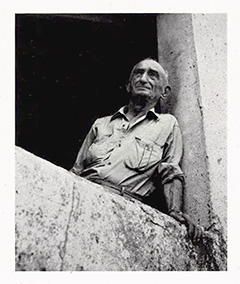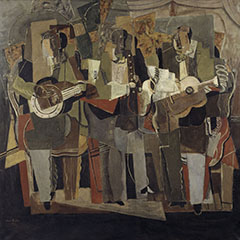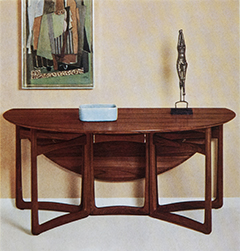Henri Hayden's Cubism

Photograph of the artist Henri Hayden.

Henri Hayden: "Bretonne". Signed Hayden. 109 x 49.5 cm. Estimate: DKK 2-3 million.

Henri Hayden's main work "Les Trois Musiciens" from 1920, today owned by the Musée d’Art Moderne / Centre Georges Pompidou in Paris. In Jean Selz' 1962 biography "Hayden", the work is described as follows: "By its shaken construction, the articulation of the visual planes, the rhythm of the colour surfaces the canvas reminds you strongly of the jazz's syncopated rhythms and movements. When you see it, you think of Paul Claudel's expression: "The eye listens". Photo: RMN-Grand Palais / René-Gabriel Ojéda.

The former owner of "Bretonne", C.W.F. France, in his factory in Hillerød in 1966. Photograph: VITA Publishing House, from the book “France & Søn – British Pioneer of Danish Furniture”.

Henri Hayden's painting "Bretonne", partly depicted in a catalogue from 1958 for "France & Søn". Photograph: VITA Publishing House, from the book “France & Søn – British Pioneer of Danish Furniture”.
The highlight of this summer's auction in Copenhagen is a magnificent painting by Henri Hayden (1883-1970) from 1920 entitled "Bretonne". With the painting’s multi-perspective space and fragmented figure and instruments, it can rightly be called pure cubist and visually musical in its style. The painting originates from the artist's relatively short cubist period between 1915 to 1922, and paintings from this period are extremely rare on the art market.
Watch the film "From a Melting Pot of Art – a Cubist Work by Henri Hayden"
Behind "Bretonne"
In "Bretonne" the spatiality is distilled into a tight modernist focus on the formalities of the painting: surface, form and colour. The colour scheme moves across a refined scale, where shades of green leap into burnt tones with contrasts of cool blue and some accents of crimson. The figure is defined precisely by the fact that different elements in the image – both in and around the figure – dissolve and shift rhythmically as the planes of the image overlap and intertwine with each other.
The work has compositional, picturesque and colouristic similarities to the major contemporary work of Hayden, "Les Trois Musiciens" (1919-20), which depicts three figures with instruments in an equally fragmented visual space. Today, this painting belongs to the Musée National d’Art Moderne in the Centre Georges Pompidou in Paris.
The title of "Bretonne" is likely a nod to one of Hayden's earliest sources of inspiration in relation to the surface-oriented, contoured and decorative painting style – namely the works of Paul Gauguin. Hayden spent several summers in Brittany, where Gauguin had established himself as a modernist in the encounter with the countryside and locals a couple of decades earlier.
In the Melting Pot of Art
Born in Warsaw, Hayden left Poland in 1907 to permanently settle in the artistic melting pot of Paris. Here he came in direct contact with the new art movements. He was, in his earliest years in Paris, engrossed in Gauguin's surface-oriented "Synthetism" and the picturesque expression of Renoir. But it was especially the constructive element of Paul Cézanne, which had a lasting influence on Hayden and led him towards the avant-garde artists of the time.
Especially the friendship with Juan Gris became crucial as Gris introduced Hayden to the art dealer Léonce Rosenberg. The two signed a contract in 1915, and Hayden thereby became part of the circle around "Galerie de L’Effort Moderne" with artists such as Pablo Picasso, Gino Severini, Jean Metzinger and Henri Matisse.
"You had to be one of the initiated before being allowed to enter the quiet Rue de la Baume and go up to the first floor, where Léonce Rosenberg, Paul Rosenberg's brother, hid his cubists. They were all there on the shelf, from Braque – the most famous – to Valmier – the least known. It was when I visited them here in their den or sanctuary that I became acquainted with Hayden's paintings."
The description comes from the author Jean Selz’ biography of Hayden from 1962 and it conjures up a 1920s image of discovering the artist's works located in their original Parisian gallery environment – surrounded by works of the most influential cubist artists.
A British Pioneer Within Danish Furniture Art
"Bretonne" comes from the art collection of Charles William Fearnley France (1897-1972), who has been described as the epitome of a classic Englishman – always wearing immaculate suits from Savile Row and tailor-made shoes from Jermyn Street, smoking a cigarette from "Players No. 3" and carrying the international edition of "The Times" under his arm. Based on this description, one can easily imagine C.W.F. France walking through the door at Marlborough Fine Art in Old Bond Street and buying this offered cubist work by Hayden.
France had a background in the textile industry and already settled in Denmark before World War II. Initially, he founded the "Lama" mattress factory, but it was after the war that he truly established a name for himself as a furniture manufacturer with companies such as "France & Daverkosen" and "France & Son". France was a true European, and mastered, besides his mother tongue, both Danish, German and French. This ear for languages gave him a great advantage in terms of being able to do business effortlessly across national borders. When France started his furniture business in Denmark, the local design scene had the benefit of a good number of talented furniture architects. On the other hand, the prevailing carpentry tradition in Denmark placed natural limits on a wider international distribution.
France's success and importance for what has become known as "Danish Modern" was with a popular modern-day expression established through a "disruption". France connected furniture art with craftsmanship and made an investment in "knock-down furniture" that could be flat-packed and subsequently assembled whereby they became profitable for export. Particular attention should be paid to the relationship with the Danish architect Finn Juhl, for whom France produced designs such as the "Japan Chair" and the "Spade Chair". Through the years, it was not only Juhl but a large part of Kaare Klint's students who ended up designing furniture pieces for France, such as Ole Wanscher, Edvard Kindt-Larsen, Grete Jalk and Hvidt & Mølgaard.
Although France often placed the furniture together with modern art in advertisements, it is less well known that he himself was an art collector with a special interest in Cubism. This summer's auction will give you a glimpse of this interest with the formidable piece by Henri Hayden, which France most likely acquired in the early part of the 1960s.
Auction: Monday 3 June at 4pm (CET) at Bredgade 33 in Copenhagen
Preview: 23-26 May at the same address
Read more about the auction
View all the lots with modern art
For further information, please contact:
Niels Raben: +45 8818 1181 · nr@bruun-rasmussen.dk
Niels Boe Hauggaard: +45 8818 1182 · nbh@bruun-rasmussen.dk